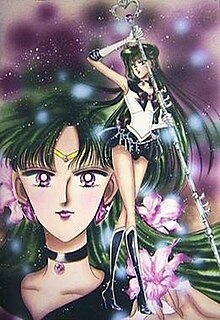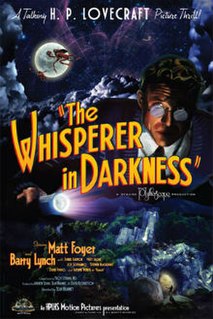
Pluto is a dwarf planet in the Kuiper belt, a ring of bodies beyond the orbit of Neptune. It was the first and the largest Kuiper belt object to be discovered. After Pluto was discovered in 1930, it was declared to be the ninth planet from the Sun. Beginning in the 1990s, its status as a planet was questioned following the discovery of several objects of similar size in the Kuiper belt and the scattered disc, including the dwarf planet Eris. This led the International Astronomical Union (IAU) in 2006 to formally define the term "planet"—excluding Pluto and reclassifying it as a dwarf planet.

Charon, known as (134340) Pluto I, is the largest of the five known natural satellites of the dwarf planet Pluto. It has a mean radius of 606 km (377 mi). Charon is the sixth-largest known trans-Neptunian object after Pluto, Eris, Haumea, Makemake and Gonggong. It was discovered in 1978 at the United States Naval Observatory in Washington, D.C., using photographic plates taken at the United States Naval Observatory Flagstaff Station (NOFS).

Nyarlathotep is a fictional character created by H. P. Lovecraft. The character is a malign deity in the Lovecraft Mythos, a shared universe. First appearing in Lovecraft's 1920 prose poem "Nyarlathotep", he was later mentioned in other works by Lovecraft and by other writers. Later writers describe him as one of the Outer Gods, a malevolent pantheon.

Mi-Go are a fictional race of extraterrestrials created by H. P. Lovecraft and used by others in the Cthulhu Mythos setting. The word Mi-Go comes from "Migou", a Tibetan word for yeti. The aliens are fungus-based lifeforms which are extremely varied due to their prodigious surgical, biological, chemical, and mechanical skill. The variants witnessed by Akeley in "The Whisperer in Darkness" look like winged human-sized crabs.

Sailor Pluto is a fictional character in the Sailor Moon manga series written by Naoko Takeuchi. The alternate identity of Setsuna Meiou, she is a member of the Sailor Guardians, female supernatural fighters who protect the Solar System from evil.

Fungi from Yuggoth is a sequence of 36 sonnets by cosmic horror writer H. P. Lovecraft. Most of the sonnets were written between 27 December 1929 – 4 January 1930; thereafter individual sonnets appeared in Weird Tales and other genre magazines. The sequence was published complete in Beyond the Wall of Sleep and The Ancient Track: The Complete Poetical Works of H. P. Lovecraft. Ballantine Books’ mass paperback edition, Fungi From Yuggoth & Other Poems included other poetic works.

"The Haunter of the Dark" is a horror short story by American author H. P. Lovecraft, written between 5–9 November 1935 and published in the December 1936 edition of Weird Tales. It was the last-written of the author's known works, and is part of the Cthulhu Mythos. The epigraph to the story is the second stanza of Lovecraft's 1917 poem "Nemesis".

The planet Mercury has often been used as a setting in science fiction. Recurring themes include the dangers of being exposed to solar radiation and the possibility of escaping excessive radiation by staying within the planet's slow-moving terminator. Another recurring theme is autocratic governments, perhaps because of an association of Mercury with hot-temperedness. Nonetheless, there may be scientific support, based on studies reported in March 2020, for considering that parts of the planet may have been habitable, and perhaps that actual life forms, albeit likely primitive microorganisms, may have existed on the planet after all.
The following tables and lists feature elements of the Cthulhu Mythos, that are often shared between works within that fictional setting.
H.P. Lovecraft’s Cthulhu: The Whisperer in Darkness was a three-part comic book mini-series published in the USA by Millennium Publications. It followed a group of investigators, the Miskatonic Project, as they confronted the Mi-go, the cunning Fungi from Yuggoth.

The Whisperer in Darkness is a 26,000-word novella by American writer H. P. Lovecraft. Written February–September 1930, it was first published in Weird Tales, August 1931. Similar to The Colour Out of Space (1927), it is a blend of horror and science fiction. Although it makes numerous references to the Cthulhu Mythos, the story is not a central part of the mythos, but reflects a shift in Lovecraft's writing at this time towards science fiction. The story also introduces the Mi-Go, an extraterrestrial race of fungoid creatures.

Pluto has been featured in many instances of science fiction and popular culture. Initially classified as a planet upon its discovery in 1930, Pluto has also received considerable publicity following a 2006 definition of planet decree and from the flyby of the New Horizons space probe in July 2015.

A dwarf planet is a planetary-mass object that is in direct orbit of the Sun and is massive enough to be plastic – for its gravity to maintain it in a hydrostatically equilibrious shape – but has not cleared the neighborhood of its orbit of similar objects. The prototype dwarf planet is Pluto.
The fictional portrayal of the Solar System has often included planets, moons, and other celestial objects which do not actually exist in reality. Some of these objects were, at one time, seriously considered as hypothetical planets which were either thought to have been observed, or were hypothesized to be orbiting the Sun in order to explain certain celestial phenomena. Often such objects continued to be used in literature long after the hypotheses upon which they were based had been abandoned.
Fedogan & Bremer is a weird fiction specialty publishing house founded in Minneapolis, Minnesota in 1985 by Philip Rahman and Dennis Weiler. The name comes from the nicknames of the two founders when they were in college.

Cthulhu's Dark Cults is an anthology edited by David Conyers, containing ten Cthulhu Mythos short stories set in Chaosium's Call of Cthulhu role-playing game setting. All the stories take place during the 1920s and 1930s, the era in which the game is set.
American author H. P. Lovecraft (1890–1937) created a number of fictional deities throughout the course of his literary career. These entities are usually depicted as immensely powerful and utterly indifferent to humans who can barely begin to comprehend them, though some entities are worshipped by humans. These deities include the "Great Old Ones" and extraterrestrials, such as the "Elder Things", with sporadic references to other miscellaneous deities. The "Elder Gods" are a later creation of other prolific writers who expanded on Lovecraft's concepts, such as August Derleth, who was credited with formalizing the Cthulhu Mythos. Most of these deities were Lovecraft's original creations, but he also adapted words or concepts from earlier writers such as Ambrose Bierce, and later writers in turn used Lovecraft's concepts and expanded his fictional universe.

The Whisperer in Darkness is a 2011 independent film directed and produced by Sean Branney, Andrew Leman, and David Robertson and distributed by the H.P. Lovecraft Historical Society. Based on the H. P. Lovecraft short story of the same name, it was shot using Mythoscope, a blend of vintage and modern filming techniques intended to produce the look of a 1930s-era film. According to the film's website, the filmmakers intended to capture the look of "classic horror films of the 1930s like Dracula, Frankenstein and King Kong".

Cthulhu Macula is a prominent surface feature of the dwarf planet Pluto, that is reminiscent of a whale in shape. It is an elongated dark region along Pluto's equator, 2,990 km (1,860 mi) long and one of the darkest features on Pluto. It is west of the Sputnik Planitia region of Tombaugh Regio, also known as Pluto's "heart", and to the east of Meng-P'o, the easternmost of Pluto's "Brass Knuckles".
This is a list of fictional creatures from the Cthulhu mythos of American writer H. P. Lovecraft and his collaborators.













